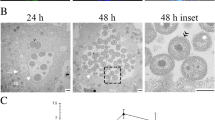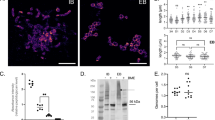Abstract.
New investigations of a novel, recently described, non-cultivable endocytobiont of Acanthamoeba sp. reveal at least three hitherto unobserved developmental stages which shed some light on the nature of this peculiar organism. The development of the endocytobiont is closely connected with conspicuous changes in the host amoeba, inducing the transformation from gel to sol-like cytoplasm which bulges like a balloon inside the host cell. Young and transitory developmental stages were found within the homogenous, sol-like cytoplasm. The infectious stages, with their voluminous cell wall and a conspicuous ostiole, could be observed within all parts of the cytoplasm with the exception of the nucleus. It is a remarkable adaptation for this parasite to be able to induce this gel-sol transformation in order to facilitate its own development. The fate of the heavily infected host amoebae is death by rupture or lysis after being overcrowded with parasites. As no structures could be observed within the endoparasites that were comparable to other bacteria, the real nature and taxonomic position of these peculiar organisms remain obscure.
Similar content being viewed by others
Author information
Authors and Affiliations
Additional information
Electronic Publication
Rights and permissions
About this article
Cite this article
Michel, .R., Müller, .KD., Schmid, .E. et al. Endocytobiont KC5/2 induces transformation into sol-like cytoplasm of its host Acanthamoeba sp. as substrate for its own development. Parasitol Res 90, 52–56 (2003). https://doi.org/10.1007/s00436-002-0710-8
Received:
Accepted:
Issue Date:
DOI: https://doi.org/10.1007/s00436-002-0710-8




